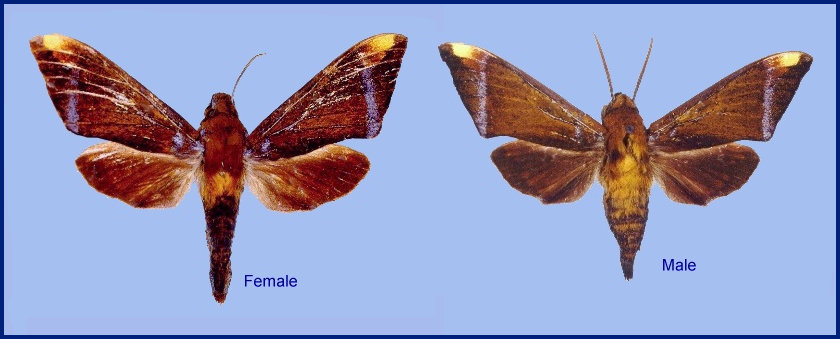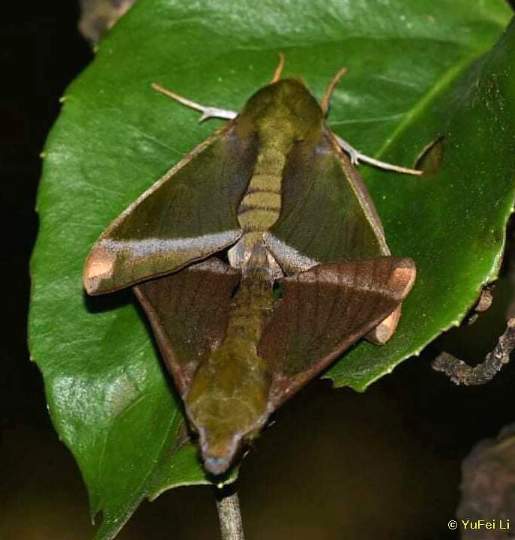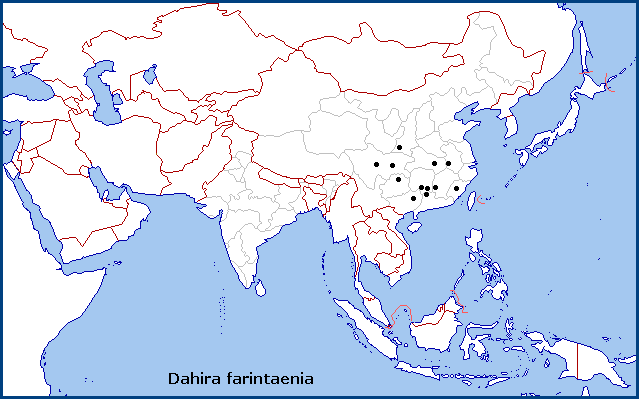


Rhodosoma farintaenia Zhu & Wang, 1997, Fauna Sinica (Insecta) 11: 318. Type locality: China, Jiangxi, Ciping.
Synonym. Rhodosoma farintaenia Zhu & Wang, 1997.
Synonym. Hayesiana farintaenia (Zhu & Wang, 1997).
Note. This species was known for many years by an unpublished manuscript name -- "Schausanus barnesi Clark, 1939", with two specimens in the Carnegie Museum of Natural History, Pittsburgh, Pennsylvania, USA [see above]. This name has been superseded by the above published name.
An unmistakable species. Upperside of wings almost uniformly dark olive green in fresh adults (fading to brown in older specimens), with a narrow diffuse pale purple-grey band running from the costa near the apex to the tornus, distal to which is a conspicuous pale apical yellow spot between Rs2 and Rs4; costal margin pale grey. Thorax and abdomen upperside olive green in fresh adults, basal tergites yellowish. Underside of thorax and abdomen underside ochre. Legs white.
In the male genitalia, uncus and gnathos form a typical macroglossine 'bird-beak' structure. Uncus thin and slightly curved, with tiny apical hook, sparsely hairy dorsally. Gnathos slightly thicker than uncus, apex blunt. Valva rounded, with basal part wider than terminal part, apex slightly blunt. Sacculus slightly constricted and slightly curved upward apically into harpe. Phallus long and straight, with transverse process distally; anterior lobe of process longer, ending into slender transverse hook with apical spinules on two sides (Jiang, Xu, Cheng, Li & Hu, 2023).
In the female genitalia, anal papillae apophyses sharp. Lamella antevaginalis sclerotized and narrow; lamella postvaginalis blunt; ostial lobe elongate and narrowed. Antrum strongly sclerotized, tubular and curved slightly obliquely. Ductus bursae tubular and membranous, narrower than antrum. Corpus bursae round, signum a leaf-like ovoid sclerotized patch, with tiny spines on both sides (Jiang, Xu, Cheng, Li & Hu, 2023).

Broad-leaved evergreen forest in Shaanxi, Chongqing and Sichuan at between 700 and 1500m altitude, depending on latitude (Jiang, Xu, Cheng, Li & Hu, 2023). Can be quite common at certain times in certain places (Xu ZhenBang, pers. comm. 2023).
China: 25.iv (Simian Shan National Forest Park, Chongqing); 12.iv (Leigongshan Nature Reserve, Guizgou); 23-30.iv (Nanping); 6.v (NanLing National Forest Park, Guangdong); v (Dayao Shan); 7-8.v (Hanzhong; Gucheng); 10.v (Ya'an, Sichuan); 15-20.viii (Sichuan); 24.v (Ciping).
Unknown.
Larval hostplants. Unknown.
Unknown.
China: Shaanxi (Gaobeicun, SE Hanzhong, 700m; Gucheng, 800m; Hanzhong, Chenggu County, 1100m); Anhui; Hubei (Tapien Shan, NE Wuhan); Sichuan (Qingcheng Shan, 50km W Chengdu, 1500m; Ya'an, Xingjing County, 1500m,); Chongqing (Simian Shan National Forest Park, 1100m); Guizhou (Leigongshan Nature Reserve, 1000m); Hunan (Yizhang); Jiangxi (Ciping); Fujian (Yanping/Nanping, 1500m (26°52'N 118°7'E)); Guangdong (Nanling National Forest Park); Guangxi (Jinxiu County, Dayao Shan).
Endemic to eastern China.

Holarctic; eastern Palaearctic region. Pleistocene refuge: Monocentric -- Sinopacific refugium.
 Return to Sphingidae of the Eastern Palaearctic species list
Return to Sphingidae of the Eastern Palaearctic species list